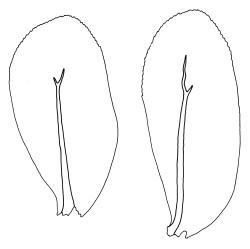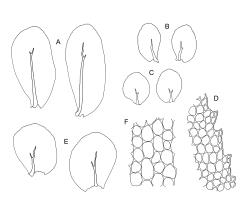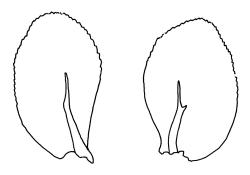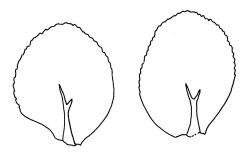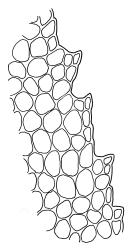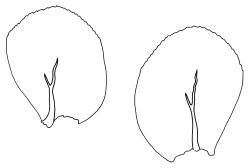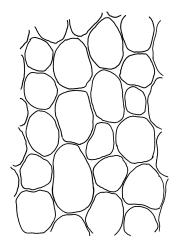- ≡ Hookeria dentata Hook.f. & Wilson, London J. Bot. 3: 550 (1844)
- ≡ Pterygophyllum dentatum (Hook.f. & Wilson) Dixon, J. Linn. Soc., Bot. 40: 455 (1912)
- = Hookeria denticulata Hook.f. & Wilson, Bot. Antarct. Voy. I. (Fl. Antarct.) Part I, 143 (1845) nom. illeg.
- = Hookeria nigella Hook.f. & Wilson in Wilson, Bot. Antarct. Voy. II (Fl. Nov.-Zel.) Part II, 124 (1854)
- ≡ Pterygophyllum nigellum (Hook.f. & Wilson) Mitt., Hooker's J. Bot. Kew Gard. Misc. 8: 264 (1856)
- = Hookeria robusta Hook.f. & Wilson in Wilson, Bot. Antarct. Voy. II (Fl. Nov.-Zel.) Part II, 124 (1854)
- ≡ Pterygophyllum robustum (Hook.f. & Wilson) A.Jaeger, Ber. Thätigk. St. Gallischen Naturwiss. Ges. 1875–1876: 343 (1877)
- ≡ Pterygophyllum dentatum var. robustum (Hook.f. & Wilson) Dixon, Bull. New Zealand Inst. 3: 289 (1927)
- = Hookeria curviseta Colenso, Trans. & Proc. New Zealand Inst. 18: 233 (1886)
- = Hookeria macroneura Colenso, Trans. & Proc. New Zealand Inst. 18: 283 (1886)
- = Hookeria obtusata Colenso, Trans. & Proc. New Zealand Inst. 18: 233 (1886)
- = Hookeria pseudopetiolata Colenso, Trans. & Proc. New Zealand Inst. 18: 231 (1886) – as pseudo-petiolata
- = Hookeria ramulosa Colenso, Trans. & Proc. New Zealand Inst. 18: 232 (1886)
- = Hookeria subsimilis Colenso, Trans. & Proc. New Zealand Inst. 18: 232 (1886)
- = Hookeria telmaphila Colenso, Trans. & Proc. New Zealand Inst. 19: 279 (1887)
- = Hepaticina cyclophylla Müll.Hal., Hedwigia 41: 124 (1902) nom. inval.
- ≡ Pterygophyllum cyclophyllum Broth., Nat. Pflanzenfam. [Engler & Prantl] 1(3), 932 (1907) nom. nov. pro Hepaticina cyclophylla Müll.Hal. 1902
- = Hepaticina nanocaulis Müll.Hal., Hedwigia 41: 126 (1902) nom. inval.
- ≡ Pterygophyllum nanocaule Broth., Nat. Pflanzenfam. [Engler & Prantl] 1(3), 932 (1907) nom. nov. pro Hepaticina nanocaulis Müll.Hal. 1902
- = Hepaticina parvula Müll.Hal., Hedwigia 41: 125 (1902) nom. inval.
- = Hepaticina pseudo-obscura Müll.Hal., Hedwigia 41: 125 (1902) nom. inval.
- ≡ Pterygophyllum pseudo-obscurum Broth., Nat. Pflanzenfam. [Engler & Prantl] 1(3), 932 (1907) nom. nov. pro Hepaticina pseudo-obscura Müll.Hal. 1902
- = Hepaticina zuerniana Müll.Ha., Hedwigia 41: 126 (1902) nom. inval. – as Zürniana
Plants oily grey-green when fresh, yellow-green to brown, often black in patches or throughout when dry. Stems sparsely branched or unbranched, red-brown to black, c. 10–20(–45) mm in terrestrial forms, much longer (to c. 90 mm) in aquatic forms, in cross-section the outermost 4–5 cell layers with thickened walls. Shoots to 10 mm wide. Leaves inserted in 8 ranks (ranks often obscure in less developed material), imbricate to distant, moderately to strongly crisped when dry, often deciduous, those in dorsal and ventral ranks broadly ovate, those in lateral ranks obovate-spathulate, broadly oblong, or ± elliptic, with broadly rounded or rarely ± acute apices, irregularly and sharply dentate (the teeth often multi-cellular) in upper half or more, rarely nearly entire, 2–6 × 1–3 mm (dorsal leaves smaller); upper laminal cells (at level of costa terminus, midway to margin) rather thin walled (2–4 µm at thinnest part), markedly thickened at corners, the exposed (abaxial and adaxial) walls very thin and collapsing when dry, (36–)54–75(–90) µm in greater diam., becoming gradually longer towards base; marginal cells somewhat smaller in several rows but not strongly differentiated. Costa unequally bifurcate in upper third, c. 80–210 µm wide in lowest third (above basal dilation), the longer branch extending ½ to ¾ (rarely less) the length of the leaf. Gemmae frequent on leaf margins of sterile plants, L-shaped or filamentous, to 5 cells and 105 µm long. Pseudoparaphyllia to c. 1650 µm long, irregular in outline (lanceolate, ovate, or 2–3-lobed), toothed or ciliate at margins.
Dioicous. Perichaetial leaves acute from an oblong base. Perigonia globose to ovoid, scattered on ♂ stems, 1.5–2 mm long. Setae c. 9–30 mm; capsules obovate from a moderately defined neck, (1.5–)1.8–2.8 mm, moderately constricted below the mouth when dry, dark yellow-brown; operculum high conic, c. 0.8 mm. Exostome teeth variable in length, c. 370–750 µm long (apices often broken), transversely striate, with a furrow c. 20 µm wide near base, and extending c. ¾ the length of the tooth, with strong marginal trabeculae; endostome segments c. 180–200 µm long, keeled but not perforate, arising from a high (≥255 µm) basal membrane. Calyptra c. 2.0–2.7 mm, smooth, lacerate at base. Spores spherical, 12–15(–18) µm.
Streimann 1997, fig. 1; Beever et al. 1992, fig. 69 a–f; Buck et al. 2002, p. 83; Meagher & Fuhrer 2003, p. 33; Seppelt 2004, fig. 69.
NI: N Auckland, including offshore islands (TK, HC, LB, GB, RT), S Auckland, Gisborne, Hawke’s Bay, Taranaki, Wellington; SI: Nelson (including Stephens I., D’U), Marlborough, Canterbury, Westland, Otago, Southland, St; Sol; Sn; A, C, M.
Austral. Tasmania*, mainland Australia*, Rarotonga*, Argentina (Tierra del Fuego)*, Chile*. Reported from New Guinea by Tan & Robinson (1990). Reported as an adventive from glasshouses and from one garden locality in Cornwall, England, by Smith (2004).
Occurring in a wide range of habitats. Most commonly on rock, rotten logs, or soil, and associated with flowing or cascading water. This species often grows submerged. When not closely associated with streams, it usually occurs under damp, shaded forest conditions. It less commonly grows on exposed roots, tree trunks (e.g., Metrosideros), and even (rarely) epiphyllously on ferns. In limestone areas it can become encrusted with calcium carbonate deposits. On the North I. occurring from sea level to at least 760 m and on the South I. ascending to c. 1500 m.
The morphological variability of A. dentatum is protean and has led to this species being repeatedly described. A broad view of this species is taken here. The observed variability is clearly related to environmental factors, chiefly water availability. Plants growing in drier habitats (i.e., on rotten logs or shaded soil banks) generally have short stems (rarely more than 20 mm) and imbricate, weakly to moderately crisped leaves of firm texture, which occasionally blacken upon drying. Plants growing in moister conditions exhibit larger stature, more distant, more crisped, and darker (when dry) leaves. Aquatic forms have stems to 60 mm or more and distant, strongly crisped, usually strongly blackened (when dry) leaves. Additionally the laminal cells of aquatic material have thinner walls and the leaf margins are less strongly toothed than terrestrial collections. The tendency for aquatic material to be more strongly pigmented parallels that in some species of Distichophyllum. Terrestrial specimens that turn black upon drying are often associated with extremely moist microhabitats.
Robust specimens (with shoots >10 mm wide, lateral leaves >5 mm and neither blackening nor crisping upon drying) are occasionally found and it is this expression to which the name Hookeria robusta Hook.f. & Wilson (or its homotypic synonyms) has been given.
Material from the Turitea Stream (Tararua Range, Wellington L.D.) gathered by V.D. Zotov (27 Aug. 1933; CHR 6822) compares well in all morphological features to the type of Hookeria robusta and is taken here to represent Dixon’s concept of Pterygophyllum dentatum var. robustum (Hook.f. & Wilson) Dixon.
Material that clearly shows the transition between the strongly crisped and black-pigmented expression characteristic of submerged environments and the less crisped, yellow-green to brown "robustum" expression is not rare, and indeed, some duplicates of the type of Hookeria robusta show such transition. Material in N.Z. herbaria showing similar transitions includes B.H. Macmillan 72/444 from Reefton (Nelson L.D., CHR 164872), K.W. Allison 1581 from Mt Cargill (Otago L.D., CHR 576904), and J.E. Beever 22–85 from Great Barrier I. (North Auckland L.D., CHR 104656). Such forms are often associated with seepage and other waterlogged, perhaps boggy, terrestrial situations. The "robustum" growth form of A. dentatum appears to be an emergent form associated with seepages.
Other N.Z. names of dubious value are mentioned under ‘excluded taxa’ above.
Type specimens of Tasmanian, Australian, and South American names have been examined as an incidental part of this study. From Tasmania, the holotype (Archer s.n., NY-Mitt.!) of Pterygophyllum obscurum Mitt. appears to be an aquatic expression of A. dentatum. From mainland Australia, type material ("Sealer’s Cove et Steep Bank River", Victoria; F. Müller s.n., BM!) of Hookeria hepaticaefolia Müll.Hal. & Hampe and of Pterygophyllum wattsii Broth. (Wilson’s Creek, Richmond River, N.S.W., W.W. Watts, BM!) are likewise referable to A. dentatum. Both these mainland names were considered synonyms of A. dentatum by Streimann (1997).
I have also referred syntype material (Chile, Port Gallant, Savatier, NY-Mitt.!) of Achrophyllum magellanicum (Besch.) Matteri to Achrophyllum dentatum. South American material has more strongly toothed leaf margins and a greater tendency towards acute leaf apices, providing some justification for recognising A. magellanicum at the varietal level. However, after examining c. 50 southern South American (mostly Chilean) collections, I have concluded that too much morphological overlap occurs between South American and Australasian material to permit the recognition of A. magellanicum at any taxonomic rank. Material from Banks Peninsula (Canterbury L.D., B.H. Macmillan 79/282, CHR 357560) is an example of N.Z. plants with the strongly toothed leaf margins and ± acute apices that are often observed in South American material. Similar material has been seen from Tasmania (J.D. Hooker 1360, BM). Argentinian isotype material of Pterygophyllum magellancium var. oligodontum Matteri (CHR 414453), and other collections so-named by Matteri, are less strongly toothed than most South American material, but unremarkable for the species when considered in a wider geographic context. Matteri’s varietal isotype is comparable to the short stemmed, moderately crisped, and non-blackened terrestrial forms of A. dentatum, which are common in N.Z.



